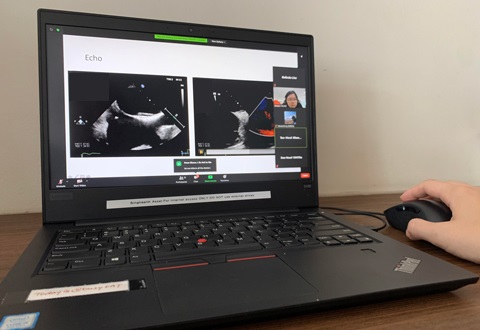Dr Teo Hooi Khee, a senior resident in Department of Cardiology has to seek new ways and opportunities to continue her learning activities and the medical education for the junior doctors amid the pandemic.
Embracing technology enables Senior Residents like Dr Teo Hooi Khee (above) to continue on their medical education journey amid the healthcare pandemic.
While already grappling with the changes that Covid-19 has brought to her daily work, Dr Teo Hooi Khee, a senior resident in Department of Cardiology has to also quickly seek new ways and opportunities to continue her learning activities and the medical education for the junior doctors. Dr Teo is actively involved in teaching sessions coordinated by the Office of Training and Education (OTE).
Learning then: Up close and personal
Less than two decades ago, the main approach to a medical education was pretty much teacher-centred, “Didactic teachings and bedside tutorials were the norm. Over the years, the interaction between teachers and students became much more interactive and personal,” Dr Teo said.
“It feels surreal that just six months ago, we could still easily gather during pockets of free time to run through an interesting case or ponder over ECGs with the juniors. Bedside teachings could also be done as and when the situation called for it,’” she added.
When the pandemic hit
When coronavirus struck, the education sphere underwent yet another evolution, albeit somewhat hastily, “All of a sudden, teachings were cancelled one after another as the priority of healthcare turned to pandemic containment. Wards were also closed to newly rotated medical officers – one of the hardest hit groups as they could no longer benefit from the weekly ward teachings conducted by the consultants.”
“We quickly found that the best way to get around the situation was teaching on the ground – we likened it to ‘opportunistic teaching’ – since ward rounds have to be conducted pandemic or not, consultants and senior residents jumped on the chance to review patients and at the same time, squeeze in teachings to the juniors in the team.”
Bridging the gaps with technology
As the crisis raged on, the OTE which oversees the learning needs of our doctors and fellows had to up their game, “We couldn’t cancel our teaching sessions indefinitely and had to find ways for the clinicians to continue acquiring new skills. The obvious platform was clear – teleconferencing was the way to go,” said Oh Seow Fong, Manager, OTE.

Virtual teachings and discussions have become the new norm for senior and junior doctors alike.
“When Webex and Zoom were first introduced to us as options for teaching platforms, we found ourselves grappling with various challenges all at once - learning new technology, troubleshooting seemingly simple details such as internet connection and audio, and even getting used to the cyber setting were part of the learning curve! Now, we find these virtual lessons highly convenient as we can attend the lessons wherever we are,” Dr Teo shared.
With this new norm, Dr Teo shared that while there will be areas that lack, opportunities abound too such as an increased availability of online meeting platforms, and international conferences that have been made readily available in these unprecedented times.
“Humans are highly adaptable. Just as we have settled into this new rhythm, I feel that new ways of teaching will certainly surface as well. Meanwhile, we should continue to learn from the patients – read their case history, look at their scans – they are our best teachers.”
